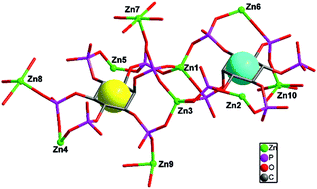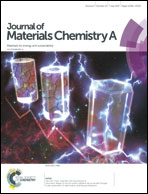An acid-stable hexaphosphate ester based metal–organic framework and its polymer composite as proton exchange membrane†
Abstract
Use of a proton exchange membrane (PEM) is a key technique in proton exchange membrane fuel cells (PEMFCs) for clean energy applications. Recently, use of metal–organic frameworks (MOFs) as well as their composite membranes with polymers as PEM have been one research focus in this area. In this paper, the synthesis and proton conductive properties of a novel hexaphosphate ester-based MOF, JUC-200, prepared by the reaction of the inositol hexaphosphoric ligand (phytic acid) and Zn(II) is described. JUC-200 shows excellent water tolerance and acid resistance in a solution of pH = 2.0, and exhibits a proton conductivity of 1.62 × 10−3 S cm−1 at 80 °C. Furthermore, the polymer composite membranes of poly(vinyl alcohol) (PVA) and JUC-200 were fabricated for use as fillers with different mass percentages (X%, the membrane denoted as JUC-200@PVA-X). The measurement of proton conductivity of these membranes shows that JUC-200@PVA-10 has the advantage of a good proton conductivity of 1.25 × 10−3 S cm−1 at 50 °C. As far as is known, this is the first water-stable and acid-stable composite made of MOFs and polymers as proton exchange membranes. This research may make some contribution to the further development of MOFs in the field of the PEMFCs.



 Please wait while we load your content...
Please wait while we load your content...